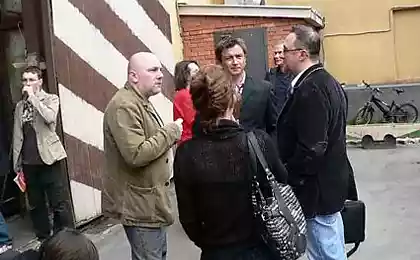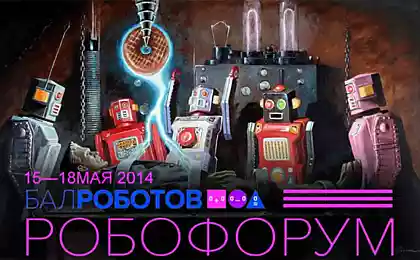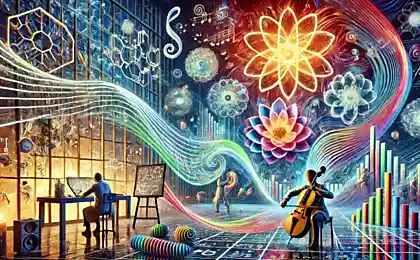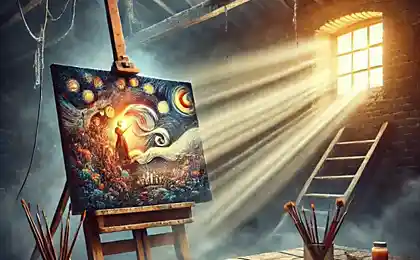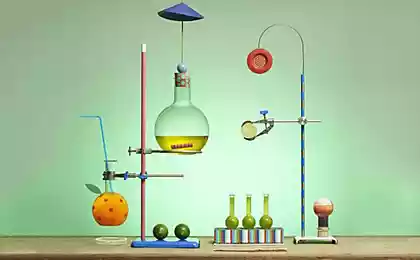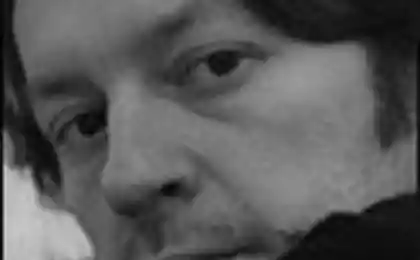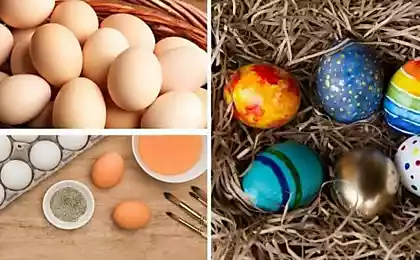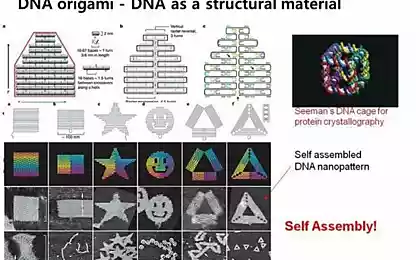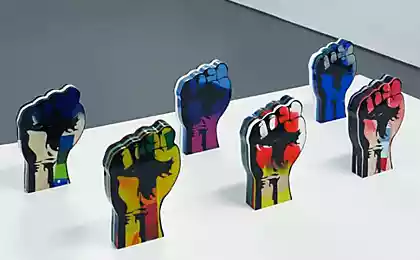1122
10 amazing art projects at the intersection of art and science
Flying thoughts and chuvstv
Some modern art objects evoke the viewer's desire to quickly get away, not to see this "masterpiece works of contemporary art," and then destroy it along with the artist, which is at the behest of " something "came to light. Fortunately, there are among today's artists and those who really create true masterpieces, including - using the latest scientific achievements and incredible technical tricks. To your attention - installations and performances, blurs the line between science and art.
1. Paper Sculpture Whether Hunbo
As is known, sculptor prefer to work with materials that keep their shape well, such as stone, metal or clay. Chinese Li Hongbo decided to go their own way - it creates sculptures of ... paper. At first glance, the creation Hongbo do not differ from clay or stone sculptures, but they have unique properties that can not boast of ordinary statue - elasticity. Sculptures Hongbo can bend, stretch and twist as you like - they always regain their form.
Amazing flexibility is achieved through a special technology sculptures - they consist of thousands of sheets of paper connected by a sticky substance. Hongbo has created several dozen sculptures, among them - the bust of the ancient goddess Athena and a copy of the head of the famous "David" by Michelangelo. Some Chinese sculptor works can be seen in New York «Klein Sun Gallery».
2. "beach beasts" Theo Yansena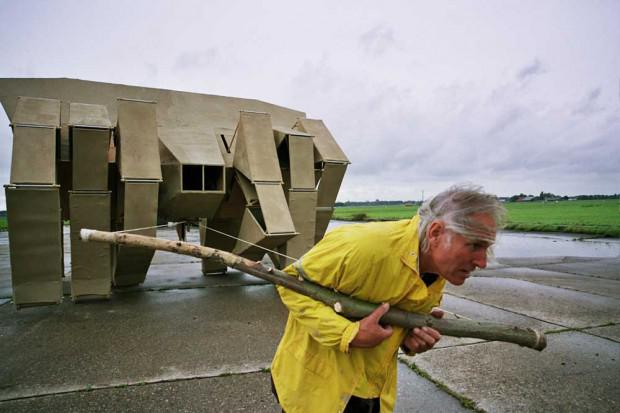
Humanity has long since learned to use the wind to your advantage - for example, wind power, which every year in the world there are more, allow to produce cheap electricity, and they are easy to maintain, and trouble in their work is much safer for the environment than, say, accidents at nuclear power plants.
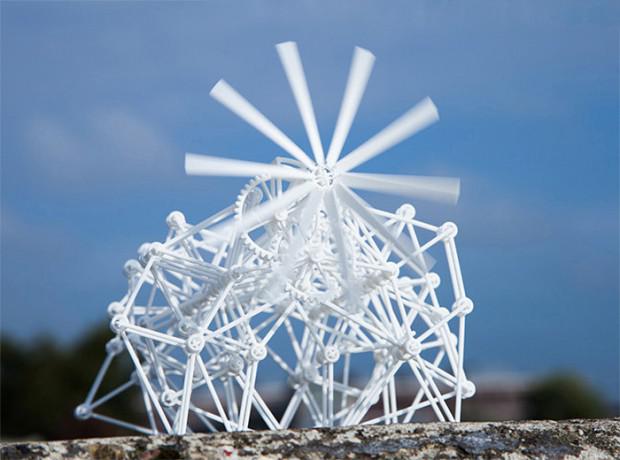
For the Dutchman Theo Jansen wind is the source of inspiration for the unusual kinetic sculptures that he calls «Strandbeest» (in the lane. With the goal. - "Beach beasts"). His creations are able to move without human intervention, using only the force of the wind. To create your own works of engineering and sculptural art Theo uses cheap materials, which can be found in any trash can.
At the heart of Jansen created "The Beast" - complex structures out of plastic pipes, bottles and original sails. When the wind blew up the sail, they set in motion a special pumps that fill bottles with compressed air. Overcrowded bottle vented excess air, causing the entire statue to move - in this case it seems that the "beach beast" comes to life.
3. Burial mycelium Zhe Rome Li
Many believe that after death his body becomes different "building blocks" for the formation of soil. Unfortunately, this is not true - decomposing corpse "enrich" the soil of various toxic substances, accumulated during the life of the body, so that the burying of bodies in the ground - not the best burial tradition in terms of ecology. The artist Jae Lee Rome found an unexpected solution to this problem - as part of its «Infinity Burial Project» she developed a special burial suit, accelerate the decomposition of the body, and significantly reduces the amount of toxins into the soil.
An experimental prototype of a kind Savannah, which Lee jokingly calls "ninja pajamas", covered with fungal spores - in fact, it is a huge mycelium, entangle suit top to bottom. In order to "activate" the clothes, you need to put on the surface of the body a special "cream", consisting of rastёrtyh dried fungal spores and minerals. The artist says that after the burial of the deceased in the suit it invented the mushrooms start to grow quickly and rotting corpses.
His know-how Lee wants not only to improve the environmental situation on the planet, but also to remind everyone that death - is only the beginning of human impact on the environment.
4. Lunar House Michael Genberga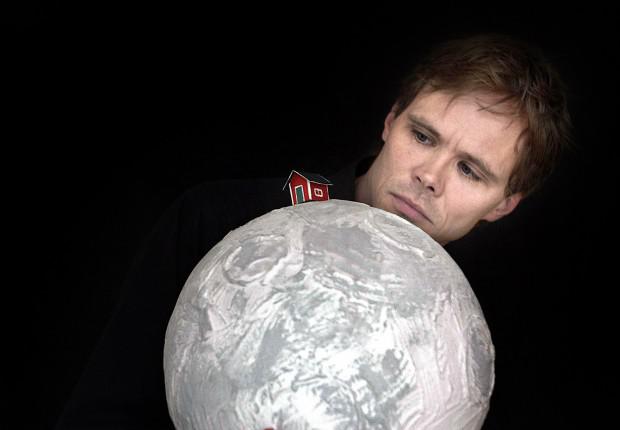
The essence of an art project Swede Mikael Genberg is to send a satellite earth red house, built in a traditional Swedish style - according to the artist, it is to "breathe life" into the desert moonscape. In an unusual project was inspired by the Swedish Space Corporation (Swedish Space Corporation - SSC) - Genberg hit on the idea after he heard that the SSC is going to send to the lunar orbit its own satellite.
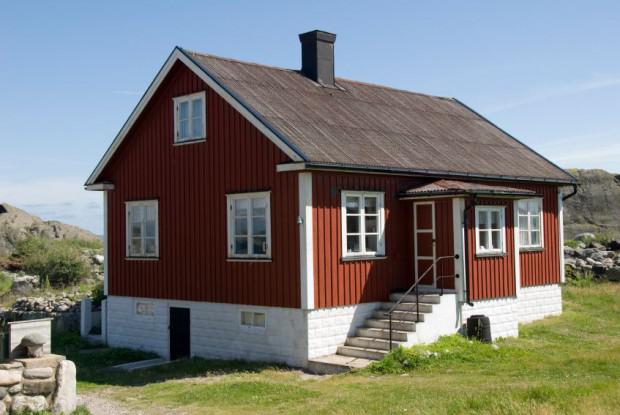
Approximate cost of transportation home to the moon - about $ 15 million, which the artist hopes to raise with the help of donations from all over the world. Michael says that his project will become the first ever space mission, funded by ordinary people, not the governments of different countries, with names of those who donate $ 50 or more, expected to engrave in "Moon House." "Why is it planned to send the Swedish home?" - You ask. The fact that one of the organizers of the project «Falu Rodfarg» - manufacturer of so-called falunskoy red paint, which in Sweden is traditionally stained wooden houses.
5. The Philosopher's Stone found! 66,463,910
Conversion of various metals into gold Alchemists raved hundreds of years ago, but none of them did not manage to translate this idea into reality. Closest to the production of gold almost "out of nothing" came Adam Brown and Kazem Kashef, two employees of the University of Michigan - they have developed a technology highlight of the precious metal from tetrachloroaurate (III) of hydrogen, which is also known as chloroauric acid.
Most of the gold that exists on our planet millions of years, formed under the influence of pressure and high temperatures, but there are faster ways to produce the metal. In my research Kashef Brown and found that the bacteria species Cupriavidus metallidurans able to multiply and grow in a concentrated solution of gold chloride - liquid toxic compounds that are often found in nature. Thus formed wastes bacteria - that other, as a solid 24-carat gold! Thus, Cupriavidus metallidurans can be considered a kind of "philosopher's stone", on finding that scientists struggled more than a century. By creating a special bioreactor with these bacteria, the researchers some time received the first gold nuggets of the highest standard.
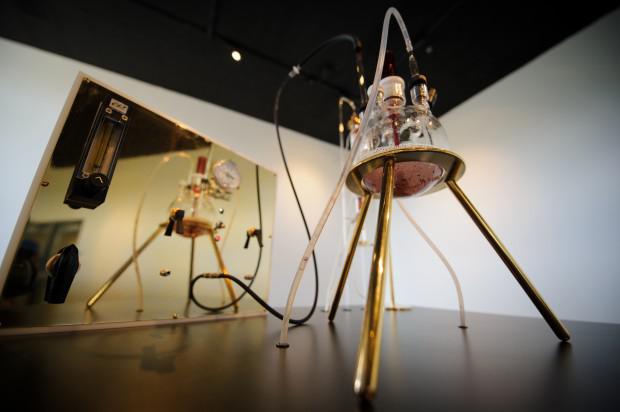
His bioreactor scientists used to create the installation entitled "The great work of metal fans." Brown and Kashef offer to everyone to enjoy the alchemical process of production of gold in real time.
6. "The best fat for soap - human"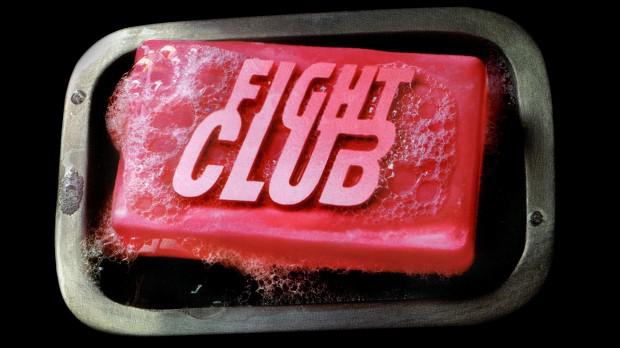
Probably many of you remember the famous work of Chuck Palahniuk "Fight Club", based on which was filmed by David Fincher, movie. Among other things, the main character of the book involved in the production of soap from human fat, kidnapped them from landfills liposaktsionnyh clinics.
Surely it is the "Fight Club" prompted Orestes de la Paz, an artist from Miami to create their own soap from fat. Some time ago, the artist went through liposuction, and he had the idea to use the recovered oil in one of the art projects, and he came up with (and most have spied Palahniuk) way to perpetuate, in the words of Tyler Durden, "your fat ass." Orestes de la Paz has made a few bars of soap, remembering the entire process on video. Currently, his works are exhibited in of Miami «Frost Museum», moreover there is a lot of visitors who want to wash their hands unusual art objects.
7. "Rainy room"
Imagine - you walk down the street in the pouring rain, but remains completely dry, because not a single drop does not fall on you. Approximately experiencing sensations Visitors installation «Rain Room», situated in one of the art galleries of London - where else to place "rainy room", not in a city known for its "wonderful" weather ?! The area of installation, created by specialists of «Random International», is 100 m² and each square centimeter here comes a real downpour, but when in the "room" includes a person directly above them, a small area where there is no rain. Guests can freely move around the room, with a dry "spot" follows him everywhere, creating the illusion of "weather control».
Wonder effect is achieved by a combination of art and modern technologies - "Rainy room" there are several cameras track the movement of visitors and with the help of special technology of sending recorded movement in the device, creating a "rain", and they cut off the flow of water exactly where at the moment The visitor.
8. "Betrayal immunity"
The artistic value of many works of art is not obvious and depends for the most part, from the imagination of the viewer. For example, some see in the "Black Square" by Malevich painting genius, while others believe the great avant-garde con artist who managed to convince people that his primitive daub - a new word in painting.
Be that as it may, there are art objects, artistic merit that it is not necessary to question - interesting to look at them even simple inhabitants, not too tempted to contemporary art. These include the installation «The Treachery of Sanctuary» (translated as "The Betrayal of immunity"). A work of interactive art consists of three vertical panels, measuring three by three meters each, which displays the processed and distorted silhouette spectator standing in front of an art object - something like a distorting mirror, only much more complex and more refined.
Installing motion capture cameras with the technology of Kinect, special software creates a model silhouette and adds to it spectacular detail, then the result is displayed on the panel. On the first screen, the shadow of a man falls into a variety of birds, which symbolizes the birth, the second bird attacked shadow and tear it to pieces, representing the cruelty, and the third part of the installation shows how a person "grow" wings - so Chris Milk, the author installation depicted death. According to the artist, his "betrayal" to tell people the story of the birth, death and transformation with the help of their own shadows.
9. Automatic cesspool Wim Delvua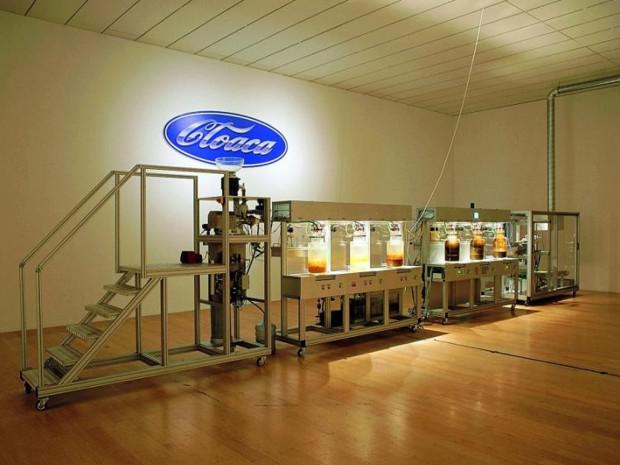
Belgian Wim Delvoye - one of the most controversial artists of our time, as in all his works he strives to combine beauty with something disgusting and repulsive. A masterpiece with the telling name of "Cloaca» («Cloaca») is one of the most famous of his works, and is nothing but a machine for the production of feces. Incredibly complex in design machine can be called a working model of the digestive tract - loaded in her food through a variety of chemical and physical processes turns into a you-know-what. "Cloaca" is made up of various components, such as tanks with acid and bacteria, pumps, reactor computer control and a whole heap of other gimmicks - all together it makes it possible to simulate the work of the human digestive system.
Art object is set to the "Museum of Modern Art" in New York, with an artist regularly holds public demonstrations of its capabilities. Delvoye Finely chop different foods and sends food to the "mouth" of the machine, and then flooded to the same any drink (for example, the Belgian beer), and then we can only wait for the food to "digest" - a process that takes about 22 hours. The final chord of the process - defecation, with dedicated "Cloaca" dung are no different from those obtained more "traditional way" of human faeces no color, no shape, no smell.
10. Robotvorchestvo
When it comes to art, there is always a view of something that man has created, because according to our ideas, creativity is inherent only member of the species homo sapiens. A group of researchers from Atlanta set out to disprove the assertion of exclusive rights of mankind to create objects of art and developed "" - a cyborg capable of creating. Its name is an abbreviation of the expression «Multi-Electrode Array Art», which can be translated as "Art Multielektrodny array».
«MEART» consists of a "body" and control the "brain", distant from each other. The "head" of the system is located in Atlanta and includes several thousands of nerve cells from the experimental rats. "Body" cyborg is located on the other side of the planet, in the Australian city of Perth, it is the manipulators, which "brain" interacts via the Internet in real time. Artist Cyborg showing their creativity by drawing on paper and by controlling the process using the "eye", ie the camera. Works «MEART», of course, far from the "Mona Lisa," da Vinci, but impressive is the fact that everything is created superhuman intelligence.
via factroom.ru

Some modern art objects evoke the viewer's desire to quickly get away, not to see this "masterpiece works of contemporary art," and then destroy it along with the artist, which is at the behest of " something "came to light. Fortunately, there are among today's artists and those who really create true masterpieces, including - using the latest scientific achievements and incredible technical tricks. To your attention - installations and performances, blurs the line between science and art.
1. Paper Sculpture Whether Hunbo

As is known, sculptor prefer to work with materials that keep their shape well, such as stone, metal or clay. Chinese Li Hongbo decided to go their own way - it creates sculptures of ... paper. At first glance, the creation Hongbo do not differ from clay or stone sculptures, but they have unique properties that can not boast of ordinary statue - elasticity. Sculptures Hongbo can bend, stretch and twist as you like - they always regain their form.
Amazing flexibility is achieved through a special technology sculptures - they consist of thousands of sheets of paper connected by a sticky substance. Hongbo has created several dozen sculptures, among them - the bust of the ancient goddess Athena and a copy of the head of the famous "David" by Michelangelo. Some Chinese sculptor works can be seen in New York «Klein Sun Gallery».
2. "beach beasts" Theo Yansena

Humanity has long since learned to use the wind to your advantage - for example, wind power, which every year in the world there are more, allow to produce cheap electricity, and they are easy to maintain, and trouble in their work is much safer for the environment than, say, accidents at nuclear power plants.

For the Dutchman Theo Jansen wind is the source of inspiration for the unusual kinetic sculptures that he calls «Strandbeest» (in the lane. With the goal. - "Beach beasts"). His creations are able to move without human intervention, using only the force of the wind. To create your own works of engineering and sculptural art Theo uses cheap materials, which can be found in any trash can.
At the heart of Jansen created "The Beast" - complex structures out of plastic pipes, bottles and original sails. When the wind blew up the sail, they set in motion a special pumps that fill bottles with compressed air. Overcrowded bottle vented excess air, causing the entire statue to move - in this case it seems that the "beach beast" comes to life.
3. Burial mycelium Zhe Rome Li

Many believe that after death his body becomes different "building blocks" for the formation of soil. Unfortunately, this is not true - decomposing corpse "enrich" the soil of various toxic substances, accumulated during the life of the body, so that the burying of bodies in the ground - not the best burial tradition in terms of ecology. The artist Jae Lee Rome found an unexpected solution to this problem - as part of its «Infinity Burial Project» she developed a special burial suit, accelerate the decomposition of the body, and significantly reduces the amount of toxins into the soil.
An experimental prototype of a kind Savannah, which Lee jokingly calls "ninja pajamas", covered with fungal spores - in fact, it is a huge mycelium, entangle suit top to bottom. In order to "activate" the clothes, you need to put on the surface of the body a special "cream", consisting of rastёrtyh dried fungal spores and minerals. The artist says that after the burial of the deceased in the suit it invented the mushrooms start to grow quickly and rotting corpses.
His know-how Lee wants not only to improve the environmental situation on the planet, but also to remind everyone that death - is only the beginning of human impact on the environment.
4. Lunar House Michael Genberga

The essence of an art project Swede Mikael Genberg is to send a satellite earth red house, built in a traditional Swedish style - according to the artist, it is to "breathe life" into the desert moonscape. In an unusual project was inspired by the Swedish Space Corporation (Swedish Space Corporation - SSC) - Genberg hit on the idea after he heard that the SSC is going to send to the lunar orbit its own satellite.

Approximate cost of transportation home to the moon - about $ 15 million, which the artist hopes to raise with the help of donations from all over the world. Michael says that his project will become the first ever space mission, funded by ordinary people, not the governments of different countries, with names of those who donate $ 50 or more, expected to engrave in "Moon House." "Why is it planned to send the Swedish home?" - You ask. The fact that one of the organizers of the project «Falu Rodfarg» - manufacturer of so-called falunskoy red paint, which in Sweden is traditionally stained wooden houses.
5. The Philosopher's Stone found! 66,463,910
Conversion of various metals into gold Alchemists raved hundreds of years ago, but none of them did not manage to translate this idea into reality. Closest to the production of gold almost "out of nothing" came Adam Brown and Kazem Kashef, two employees of the University of Michigan - they have developed a technology highlight of the precious metal from tetrachloroaurate (III) of hydrogen, which is also known as chloroauric acid.
Most of the gold that exists on our planet millions of years, formed under the influence of pressure and high temperatures, but there are faster ways to produce the metal. In my research Kashef Brown and found that the bacteria species Cupriavidus metallidurans able to multiply and grow in a concentrated solution of gold chloride - liquid toxic compounds that are often found in nature. Thus formed wastes bacteria - that other, as a solid 24-carat gold! Thus, Cupriavidus metallidurans can be considered a kind of "philosopher's stone", on finding that scientists struggled more than a century. By creating a special bioreactor with these bacteria, the researchers some time received the first gold nuggets of the highest standard.

His bioreactor scientists used to create the installation entitled "The great work of metal fans." Brown and Kashef offer to everyone to enjoy the alchemical process of production of gold in real time.
6. "The best fat for soap - human"

Probably many of you remember the famous work of Chuck Palahniuk "Fight Club", based on which was filmed by David Fincher, movie. Among other things, the main character of the book involved in the production of soap from human fat, kidnapped them from landfills liposaktsionnyh clinics.
Surely it is the "Fight Club" prompted Orestes de la Paz, an artist from Miami to create their own soap from fat. Some time ago, the artist went through liposuction, and he had the idea to use the recovered oil in one of the art projects, and he came up with (and most have spied Palahniuk) way to perpetuate, in the words of Tyler Durden, "your fat ass." Orestes de la Paz has made a few bars of soap, remembering the entire process on video. Currently, his works are exhibited in of Miami «Frost Museum», moreover there is a lot of visitors who want to wash their hands unusual art objects.
7. "Rainy room"

Imagine - you walk down the street in the pouring rain, but remains completely dry, because not a single drop does not fall on you. Approximately experiencing sensations Visitors installation «Rain Room», situated in one of the art galleries of London - where else to place "rainy room", not in a city known for its "wonderful" weather ?! The area of installation, created by specialists of «Random International», is 100 m² and each square centimeter here comes a real downpour, but when in the "room" includes a person directly above them, a small area where there is no rain. Guests can freely move around the room, with a dry "spot" follows him everywhere, creating the illusion of "weather control».
Wonder effect is achieved by a combination of art and modern technologies - "Rainy room" there are several cameras track the movement of visitors and with the help of special technology of sending recorded movement in the device, creating a "rain", and they cut off the flow of water exactly where at the moment The visitor.
8. "Betrayal immunity"

The artistic value of many works of art is not obvious and depends for the most part, from the imagination of the viewer. For example, some see in the "Black Square" by Malevich painting genius, while others believe the great avant-garde con artist who managed to convince people that his primitive daub - a new word in painting.
Be that as it may, there are art objects, artistic merit that it is not necessary to question - interesting to look at them even simple inhabitants, not too tempted to contemporary art. These include the installation «The Treachery of Sanctuary» (translated as "The Betrayal of immunity"). A work of interactive art consists of three vertical panels, measuring three by three meters each, which displays the processed and distorted silhouette spectator standing in front of an art object - something like a distorting mirror, only much more complex and more refined.
Installing motion capture cameras with the technology of Kinect, special software creates a model silhouette and adds to it spectacular detail, then the result is displayed on the panel. On the first screen, the shadow of a man falls into a variety of birds, which symbolizes the birth, the second bird attacked shadow and tear it to pieces, representing the cruelty, and the third part of the installation shows how a person "grow" wings - so Chris Milk, the author installation depicted death. According to the artist, his "betrayal" to tell people the story of the birth, death and transformation with the help of their own shadows.
9. Automatic cesspool Wim Delvua

Belgian Wim Delvoye - one of the most controversial artists of our time, as in all his works he strives to combine beauty with something disgusting and repulsive. A masterpiece with the telling name of "Cloaca» («Cloaca») is one of the most famous of his works, and is nothing but a machine for the production of feces. Incredibly complex in design machine can be called a working model of the digestive tract - loaded in her food through a variety of chemical and physical processes turns into a you-know-what. "Cloaca" is made up of various components, such as tanks with acid and bacteria, pumps, reactor computer control and a whole heap of other gimmicks - all together it makes it possible to simulate the work of the human digestive system.
Art object is set to the "Museum of Modern Art" in New York, with an artist regularly holds public demonstrations of its capabilities. Delvoye Finely chop different foods and sends food to the "mouth" of the machine, and then flooded to the same any drink (for example, the Belgian beer), and then we can only wait for the food to "digest" - a process that takes about 22 hours. The final chord of the process - defecation, with dedicated "Cloaca" dung are no different from those obtained more "traditional way" of human faeces no color, no shape, no smell.
10. Robotvorchestvo

When it comes to art, there is always a view of something that man has created, because according to our ideas, creativity is inherent only member of the species homo sapiens. A group of researchers from Atlanta set out to disprove the assertion of exclusive rights of mankind to create objects of art and developed "" - a cyborg capable of creating. Its name is an abbreviation of the expression «Multi-Electrode Array Art», which can be translated as "Art Multielektrodny array».
«MEART» consists of a "body" and control the "brain", distant from each other. The "head" of the system is located in Atlanta and includes several thousands of nerve cells from the experimental rats. "Body" cyborg is located on the other side of the planet, in the Australian city of Perth, it is the manipulators, which "brain" interacts via the Internet in real time. Artist Cyborg showing their creativity by drawing on paper and by controlling the process using the "eye", ie the camera. Works «MEART», of course, far from the "Mona Lisa," da Vinci, but impressive is the fact that everything is created superhuman intelligence.
via factroom.ru
In a self-taught trainer has an unusual relationship with horses
Reading "Harry Potter" can make you better




